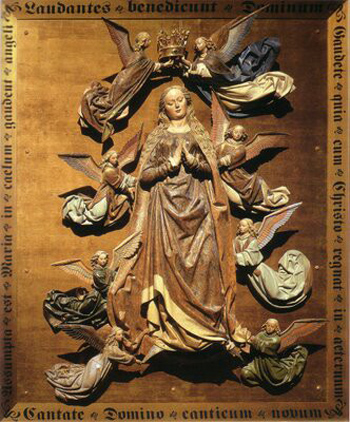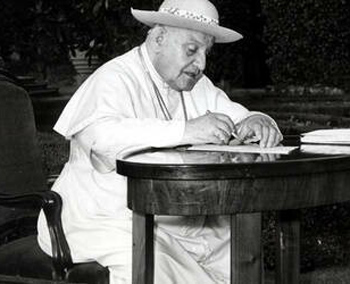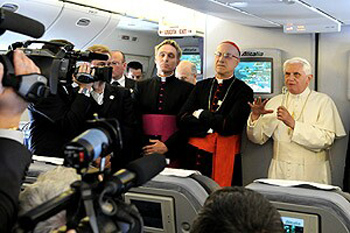Consequences of Vatican II
 |
 |
 |
 |
 |
 |
 |
Echoes from Brazil
Clarity Before the Council;
Ambiguity Afterwards
The ‘50s in Brazil was a time of great religious fervor and growing Marian devotion. I still remember the height of popularity enjoyed by the Marian Congregations, whose ranks included the Catholic leader Plinio Corrêa de Oliveira as an exemplar member and dedicated apostle. In the ‘50s I entered the Marian Congregation as a boy. For that entire decade I was proud to be a member, as were most of my friends. Our Catholic fight at that time was based on three devotions: the Eucharist, Our Lady and the Pope.
I grew up in that ambience with frequent Holy Hours before the Most Holy Sacrament, daily praying of the Rosary (15 decades), regular meetings with my fellow members and an ardent devotion to the Papacy. The recourse to papal encyclicals was constant for our spiritual improvement, to attract new members to our position and to ensure a good performance in our daily debates. They were our pocket-books, read in any spare time we had, all of them underlined and their arguments ready to be used in conversations, talks and debates.
 By the early ‘60s, that group of friends included many who were students in various universities and some who had already received their degrees. We also kept the door open to the young high-school students who were following in our footsteps. At those delightful meetings we would listen to reports of the debates each one had engaged in since the last gathering. Far from being a display of pride, those chronicles were classes in apologetics where the more experienced members passed to the newcomers the best arguments drawn from the arsenal of Catholic doctrine, explained by the Sovereign Pontiffs.
By the early ‘60s, that group of friends included many who were students in various universities and some who had already received their degrees. We also kept the door open to the young high-school students who were following in our footsteps. At those delightful meetings we would listen to reports of the debates each one had engaged in since the last gathering. Far from being a display of pride, those chronicles were classes in apologetics where the more experienced members passed to the newcomers the best arguments drawn from the arsenal of Catholic doctrine, explained by the Sovereign Pontiffs.
This was the general atmosphere in the Catholic milieu of Belo Horizonte (State of Minas Gerais) and in all cities of Brazil when we received the news that Pope Pius XII had died and John XXIII had ascended to the Papal Throne. Shortly after his coronation he convened Council Vatican II.
Many of the Catholics I knew had the hope that the impending Council would conclude the work of Vatican I, which could not be completed because of the attacks of the Masonic troops of Vittorio Emmanuelle that seized the Papal Territories and Rome itself, obliging Pope Pius IX to flee to Gaeta and suspend sine die [without a date to be resumed] the works of that Council. Later he returned and declared that, until the Papal Territories were returned to him, the Pope would remain in the condition of a prisoner in the Vatican.
Our greatest hopes were that John XXIII’s coming Council would condemn Communism, declare the dogma of the universal mediation of Our Lady and take advantage of the meeting of all the Bishops of the world together to make the consecration of Russia and the world to the Immaculate Heart of Mary, as she had commanded in Fatima.
A noticeable change
The first encyclicals of John XXIII maintained the crystal clear teaching of his antecessors. But with the appearance of Mater et Magistra in 1961, things started to change. The first translations presented the papal text as defending “socialization.”
 Prof. Plinio Corrêa de Oliveira published a comparative study of those translations based on the original Latin text published in the Acta Apstolicae Sedis, the Church’s official organ to issue documents. The conclusion of that study was that the word “socialization” had not literally been used by the Pontiff in the encyclical.
Prof. Plinio Corrêa de Oliveira published a comparative study of those translations based on the original Latin text published in the Acta Apstolicae Sedis, the Church’s official organ to issue documents. The conclusion of that study was that the word “socialization” had not literally been used by the Pontiff in the encyclical.
Notwithstanding, some months later Cardinal Amleto Cicognani, Secretary of State of John XXIII, affirmed in two different occasions that the encyclical actually was meant to favor socialization. It was the green light for socialists, communists and leftists of all tendencies to use the encyclical to promote their causes.
The documents of John XXIII that followed had less and less of that previous doctrinal clarity, which had always characterized papal pronouncements. Then, paradoxically, the enemies of the Church began to use those encyclicals against us. We had to bear the attacks made by progressivists, who continued the work of Modernism condemned by St. Pius X, as well as the whole gamut of socialists and communists.
At that time, Prof. Plinio was the editor of Catolicismo. This paper was the official organ of the Diocese of Campos, State of Rio de Janeiro, but its contributors were a group of traditionalist intellectuals of São Paulo directed by Prof. Plinio. Bishop Antonio de Castro Mayer read and approved each issue. Catolicismo had made it a point of honor to publish all papal encyclicals. After Mater et Magistra, however, that tradition ended.
The papal documents had changed their tone and started to favor and promote the left. We Catholics could no longer use them to fight for the installation of the Kingdom of Christ on earth, as we had done before. The new teachings of the Pastor of Pastors became, generally speaking, favorable to the wolves and harmful to the sheep. They were ambiguous, with teaching at variance with the tradition of the previous Papal Magisterium.
 Before, the Popes were clear and there was no need to explain what they wanted to say. Then, everything became blurred, opening doors to what the enemies of the Church defended. This disconcerting phenomenon became more and more widespread until it triumphed in the unequivocally ambiguous language adopted by Council Vatican II. This Council represented a 180-degree turn in the bi-millennial history of the Catholic Church.
Before, the Popes were clear and there was no need to explain what they wanted to say. Then, everything became blurred, opening doors to what the enemies of the Church defended. This disconcerting phenomenon became more and more widespread until it triumphed in the unequivocally ambiguous language adopted by Council Vatican II. This Council represented a 180-degree turn in the bi-millennial history of the Catholic Church.
A famous book by Plinio Corrêa de Oliveira – Unperceived Ideological Transshipment and Dialogue - deserves to be carefully studied, since it fully reveals many maneuvers and traps utilized by the enemies of the Church to try to destroy her. The author describes the background of revolutionary psychological warfare and explains how words such as dialogue, pacifism and ecumenism are used to change the convictions of those who hear or use them through a subtle process of subconscious propaganda.
We can affirm that, by means of ambiguity, Vatican II stimulated - and continues to incite - an “unconscious ideological transshipment” in a huge multitude of Catholics. Without being aware of it, they are stepping outside the borders of the Catholic Faith. On the contrary, those Catholics who remain faithful are plunged into a tortured perplexity.
In this context, the providential Collection Eli, Eli, Lamma Sabacthani? by Atila Sinke Guimarães, acquires an incalculable scope. Basically it shows the ambiguity of the documents of Vatican II. It is such a fundamental and inexpugnable work that the enemies who are exposed by it dare not even quote it, much less refute it. As far as we Catholics are concerned, we must thank Divine Providence for having given this collection to us; we must study it and disseminate it to the four winds. We should not despise God’s gift, but cultivate it.

I grew up in that ambience with frequent Holy Hours before the Most Holy Sacrament, daily praying of the Rosary (15 decades), regular meetings with my fellow members and an ardent devotion to the Papacy. The recourse to papal encyclicals was constant for our spiritual improvement, to attract new members to our position and to ensure a good performance in our daily debates. They were our pocket-books, read in any spare time we had, all of them underlined and their arguments ready to be used in conversations, talks and debates.

The growing Marian devotion awaited the dogma of her universal mediation; it was frustrated
This was the general atmosphere in the Catholic milieu of Belo Horizonte (State of Minas Gerais) and in all cities of Brazil when we received the news that Pope Pius XII had died and John XXIII had ascended to the Papal Throne. Shortly after his coronation he convened Council Vatican II.
Many of the Catholics I knew had the hope that the impending Council would conclude the work of Vatican I, which could not be completed because of the attacks of the Masonic troops of Vittorio Emmanuelle that seized the Papal Territories and Rome itself, obliging Pope Pius IX to flee to Gaeta and suspend sine die [without a date to be resumed] the works of that Council. Later he returned and declared that, until the Papal Territories were returned to him, the Pope would remain in the condition of a prisoner in the Vatican.
Our greatest hopes were that John XXIII’s coming Council would condemn Communism, declare the dogma of the universal mediation of Our Lady and take advantage of the meeting of all the Bishops of the world together to make the consecration of Russia and the world to the Immaculate Heart of Mary, as she had commanded in Fatima.
A noticeable change
The first encyclicals of John XXIII maintained the crystal clear teaching of his antecessors. But with the appearance of Mater et Magistra in 1961, things started to change. The first translations presented the papal text as defending “socialization.”

John XXIII's documents abandonned the clarity of the previous papal Magisterium to favor the left
Notwithstanding, some months later Cardinal Amleto Cicognani, Secretary of State of John XXIII, affirmed in two different occasions that the encyclical actually was meant to favor socialization. It was the green light for socialists, communists and leftists of all tendencies to use the encyclical to promote their causes.
The documents of John XXIII that followed had less and less of that previous doctrinal clarity, which had always characterized papal pronouncements. Then, paradoxically, the enemies of the Church began to use those encyclicals against us. We had to bear the attacks made by progressivists, who continued the work of Modernism condemned by St. Pius X, as well as the whole gamut of socialists and communists.
At that time, Prof. Plinio was the editor of Catolicismo. This paper was the official organ of the Diocese of Campos, State of Rio de Janeiro, but its contributors were a group of traditionalist intellectuals of São Paulo directed by Prof. Plinio. Bishop Antonio de Castro Mayer read and approved each issue. Catolicismo had made it a point of honor to publish all papal encyclicals. After Mater et Magistra, however, that tradition ended.
The papal documents had changed their tone and started to favor and promote the left. We Catholics could no longer use them to fight for the installation of the Kingdom of Christ on earth, as we had done before. The new teachings of the Pastor of Pastors became, generally speaking, favorable to the wolves and harmful to the sheep. They were ambiguous, with teaching at variance with the tradition of the previous Papal Magisterium.

Benedict's confused declarations on condoms during his flight to Africa deeply harmed Catholic morality
A famous book by Plinio Corrêa de Oliveira – Unperceived Ideological Transshipment and Dialogue - deserves to be carefully studied, since it fully reveals many maneuvers and traps utilized by the enemies of the Church to try to destroy her. The author describes the background of revolutionary psychological warfare and explains how words such as dialogue, pacifism and ecumenism are used to change the convictions of those who hear or use them through a subtle process of subconscious propaganda.
We can affirm that, by means of ambiguity, Vatican II stimulated - and continues to incite - an “unconscious ideological transshipment” in a huge multitude of Catholics. Without being aware of it, they are stepping outside the borders of the Catholic Faith. On the contrary, those Catholics who remain faithful are plunged into a tortured perplexity.
In this context, the providential Collection Eli, Eli, Lamma Sabacthani? by Atila Sinke Guimarães, acquires an incalculable scope. Basically it shows the ambiguity of the documents of Vatican II. It is such a fundamental and inexpugnable work that the enemies who are exposed by it dare not even quote it, much less refute it. As far as we Catholics are concerned, we must thank Divine Providence for having given this collection to us; we must study it and disseminate it to the four winds. We should not despise God’s gift, but cultivate it.

Posted February 17, 2014











